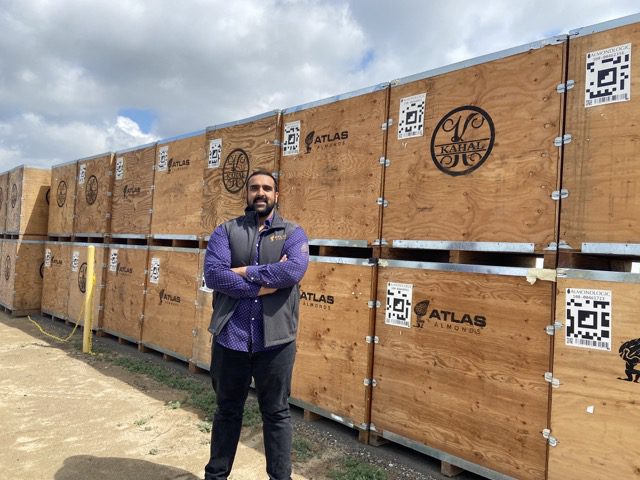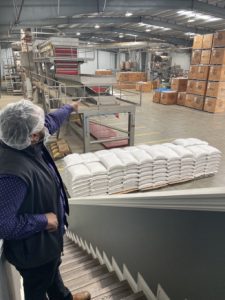
Mallvinder Kahal, managing partner at Atlas Almonds, Inc. and president of Kahal Farms, led the recent construction of an almond processor in Madera to compliment his family’s almond farming operation. Kahal began his ag career seven years ago, bringing new ideas and energy and acquiring invaluable insight about some certain farming philosophies that shouldn’t change.
The Kahal family’s acreage has doubled from 1,000 acres to 3,000 acres in Stanislaus, Madera and Merced counties, thus making the decision to build a 40,000-square-foot almond processor a natural fit.
Kahal had never worked in an almond processor before let alone build one. His approach was to avoid looking too far ahead as he managed the project.
He paced himself.
“At first, I wanted to attack it all at once. And then thought, ‘No, why don’t I focus on the smaller sub sections, one at a time,’” Kahal said.
He jokes the project took years off his life.
For Kahal, the 2021 season was the first full season in operation. Atlas Almonds sources almonds from family acreage as well as outside growers, with most of the production exported.
There seems to be a pattern in how he embraces anything “new” as an immersive hands-on experience.
When Kahal gets curious, then he is all in. He can tell you about his business stints in bee keeping and almond butter manufacturing.
Cyclical Market
Kahal joined the industry when almond prices were strong when there was an ease to managing business expenses. That’s changed in the past few years.
“I thought I knew what that meant to bare your teeth and deal with these market cycles, but I didn’t,” Kahal said.
With the uncertainty, Kahal acknowledged the generations of farmers who have endured pricing downturns in the past and survived the financial squeeze.
“I think farmers who are committed to the core ideology of having dirt on your hands and making sure you are in the field are the ones who are going to survive,” Kahal said.
Kahal’s father is that ‘type’ of farmer. The one irrigating, spraying and discing himself.
Once, he described his father’s methods as “old school,” and now, Kahal recognizes his father’s hands-on approach to farm close to the dirt is one of practicality.
“Farming is not for the faint of heart, on the physical level, mental level and financially,” Kahal said.
When asked about the next “all in” venture, he says his focus is on managing the existing operation.
“Real success comes from maintaining a focus and grind. It might seem mundane, but it is important,” Kahal said.
Not Ag
Kahal is surrounded by farming. His immediate and extended family farm throughout the state in counties that hug highway 99. The patchwork of county lines throughout California is how he identifies where the farms are located, stretching from Kern to Yolo counties.
Both his maternal and paternal relatives have been farming over multiple generations in California and the Northern Indian region of Punjab.
Many migrated to California in the 1970s and worked any job they could. He was raised listening to stories of movement throughout Central California as his family shifted crops and regions depending on where the opportunities blossomed.
As the youngest of four children, Kahal was raised to pursue ambitions fueled by higher education.
For a while, that was the plan.
At the time, Kahal was a pre-med major attending University of California Los Angeles. To get exposure in the medical field, he worked as an emergency medical technician. The experience provided clarity that the medical field wasn’t a fit.
He pivoted to an environmental science major where he found himself in the middle of emotionally charged conversations about the state’s water supply. The drought, at the time, provided a framework to hear differing perspectives.
Aside from chores around the family farm, Kahal lacked farming experience to know how to defend the ag industry from a technical perspective.
So, he used what he knew.
He responded to comments made against farming with a conversation about inputs versus outputs.
“My counter argument at that time was nutritional density. Take the amount of water used to produce a crop and compare it with the nutrition found in the food. When you compare that with nutritional supplements to add the same nutrients as the crop, then we look at the footprint of a vitamin processing plant and compare it to carbon sequestering of the trees or plants. These are the arguments that need to be a part of the conversation still today,” Kahal said.
The college experience illuminated a default mindset which omitted variables important to the conversation.

Sustainability
Kahal stands out as a well-spoken advocate who appears eager to bridge communication gaps with the folks not in the farming community.
Kahal feels strongly about sustainability and its place in the farming community.
“If you sit there silent, then the world is going to tell you what it means. We really have to take ownership of that word and drive it home,” Kahal said about defining sustainability.
Sustainability is being defined by some people who have never been on a farm.
“The conversation is happening with or without you,” he said.
What does sustainability mean?
“At its core, sustainability is what goes in (inputs) and what comes out (outputs). On a larger scale, it is the collective meaning as to what is environmentally healthy,” Kahal said.
In the ag industry, sustainability is “being good at farming where your input should match your output.”
Technology
The field of ag tech is continuously working to provide solutions to provide a more accurate picture of the variables that go into producing a crop. Unfortunately, operating in an orchard, ranch or field imposes wear and tear.
Kahal explained how technology makes sense conceptually but doesn’t always work in all situations. He used the example of automating water line gates. There are gates located in the middle of an orchard making it impossible to automate without a power source and cost prohibitive to install a new source.
Secondly, irrigating isn’t as simple as opening and closing the gate, he explained that water pressure determines the size of the opening.
“Farming is still a people-centric industry,” he said.
The issue is there is still a gap between what is practical and what is offered and expected.
Kahal explained it can be easy to dismiss technology as a whole when prior attempts to adopt technology ended poorly and cost time and resources.
Service provided by ag tech vendors has been improving, both with hardware and software, in onboarding new applications as well as maintaining equipment, Kahal said.
Kahal is one to watch. He has tenacity to navigate the ever-complex tree nut industry. In less than 10 years, Kahal has cemented his place in the California tree nut industry. His approach to blend traditional cultural practices with the ever-changing landscape and availability of ag tech is sure to yield important contributions to the industry.










